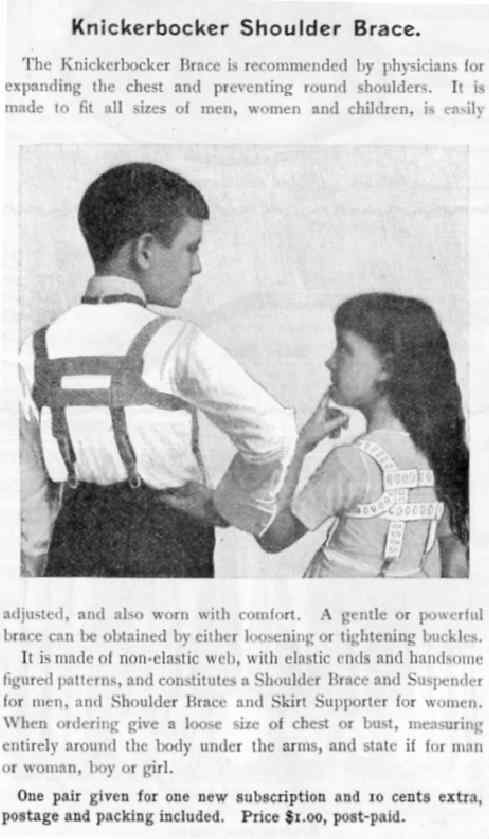
American Clothing Advertisements: Knickerbocker Shoulder Brace

Figure 1.-- This advertisement for the Knickerbocker Shoulder Brace, which appeared in The Youth's Companion (October 25, 1900) illustrates the obsession with keeping children's posture erect. The Knickerbocker Shoulder Brace, which looks as though it would be extremely uncomfortable to wear despite the claim that it can be worn "with comfort," was supposedly "recommended by physicians for expanding the chest and preventing round shoulders."
|
This advertisement for the Knickerbocker Shoulder Brace, which appeared in The Youth's Companion (October 25, 1900) illustrates the obsession with keeping children's posture erect. The Knickerbocker Shoulder Brace, which looks as though it would be extremely uncomfortable to wear despite the claim that it can be worn "with comfort," was supposedly "recommended by physicians for expanding the chest and preventing round shoulders."
Popular Attitudes
At various times in the history of children's dress parents and physicians have been obsessed with children's posture--especially the training of boys and girls to hold themselves upright in almost
military style and to avoid slumping and the onslaught of round shoulders. We notice this in America because of our greater access to information. We also believe that this was a common attitude in Europe, but have less information. In the 19th and early 20th centuries, this concern reveals itself repeatedly.
Physicians believe that from early childhood steps should be taken to incourage correct posture to prevent adult back problems. We have noted doctors expressing concerns over posture in the 19th century, althjough often without real insights into the underlying medical science. We have noted a variety of posture corrective devices in 19th century publications. Some seem rather extreme. Some 19th century doctors and parents were very concerned about posture and willing to take aggressive steps to force children to develop better posture. This continued in a less aggressive manner into the early 20th century. The waists suits worn by children in the ealy 20th century offered referred to benefecial posture. Parents today in most cases seem less willing to intervene to improve threir children's posture with the exception of occassional mild oral comments. Here there may be some differences among countries. We note that posture correcting devices are still used in Japan.
Company
I'm not sure what company manufactured these braces.
This advertisement for the Knickerbocker Shoulder Brace, which appeared in The Youth's Companion (October 25, 1900, p. 506), illustrates the obsession with keeping children's posture erect.
Other Support Devices
Many of the advertisements for children's garter waists, for
instance, tried to sell parents on the idea that such garments (apart from their obvious function as a support for long stockings) were good for boys' and girls' posture. See, for instance, HBC's pages on the "Dr. Parker style garter waist" [add link here?].
Device
The Knickerbocker Shoulder Brace, which looks as though it would be extremely uncomfortable to wear despite the claim that it can be worn "with comfort," was supposedly "recommended by physicians for expanding the chest and preventing round shoulders." The brace came in sizes for adults as well as for children, but this ad emphasizes its importance for boys and girls. The ad copy read, "Knickerbocker Shoulder Brace. The Knickerbocker Brace is recommended by
physicians for expanding the chest and preventing round shoulders. It is made to fit all sizes of men, women and children, is easily adjusted, and also worn with comfort. A gentle or powerful brace can be obtained by either loosening or tightening buckles. It is made of non-elastic web, with elastic ends and handsome figured patterns, and constitutes a Shoulder Brace and Suspender for men [and boys], and Shoulder Brace and Skirt Supporter for women [and girls].
When ordering give a loose size of chest or bust, measuring entirely around the body under the arms, and state if for man or woman, boy or girl. One pair given for one new subscription [of the Youth's Companion] and 10 cents extra, postage and packing included. Price $1.00, post-paid."
Terminology
We are unsure about the terminologu here. We are unsure as to why this was called a "Knickerbocker" Shoulder Brace. We thought this might be the name of the company. Also we thought that the term might be related to the fact that the brace attached to the trousers. But here Knickerbocker does not seem right. Boys in 1900 more commonly wore kneepants than knickers. A reader writes, " A 'Knickerbocker' means (in addition to a style of trousers) a descendant from the old Dutch settlers of New York. I think the shoulder brace may be associated in some ways with the tradition of Dutch settlements in New York. Just a guess of course."
HBC

Navigate the Boys' Historical Clothing catalog/magazine pages:
[Return to the Main American catalog 1900 page]
[Main photo/publishing page]
[Store catalogs]
[Fashion magazines]
Navigate the Boys' Historical Clothing Web Site:
[Introduction]
[Activities]
[Biographies]
[Chronology]
[Clothing styles]
[Countries]
[Bibliographies]
[Contributions]
[Countries]
[FAQs]
[Satellite sites]
[Tools]
[Boys' Clothing Home]
Navigate the Boys' Historical Clothing Web Site:
[Sailor hats]
[Fauntleroy blouses]
[Sailor suits]
[Buster Brown suits]
[Eton suits]
[Rompers]
[Tunics]
[Smocks]
[Pinafores]
[Long stockings]
[Underwear]
[Posture devices]
[Color conventions]
Created: 7:50 PM 1/17/2005
Last updated: 7:50 PM 1/17/2005



